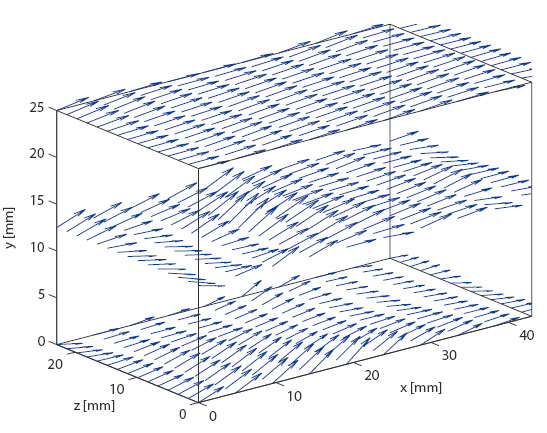XPIV- Multi-plane Stereoscopic Particle Image Velocimetry system

We (Alex Liberzon & Roi Gurka) introduce three dimensional measurement technique (called XPIV) based on a Particle Image Velocimetry (PIV) system. The technique provides three-dimensional and statistically significant velocity data. The main principle of the technique lies in the combination of defocus, stereoscopic and multi-plane illumination concepts. The results of the turbulent boundary layer in a flume are presented below. The quality of the velocity data is evaluated by using the velocity profiles and relative turbulent intensity of the boundary layer. The analysis indicates that the XPIV is a reliable experimental tool for the three dimensional fluid velocity measurements.
Experimental investigation of turbulent flows requires techniques that allow three-dimensional measurements with high spatial and temporal resolutions. Particle Image Velocimetry (PIV) is a state-of-the-art method in fluid dynamics research that provides high spatial resolution in two-dimensional slice of the flow (Adrian 1991; Raffel et al. 1998), and appears to be an appropriate basis for three-dimensional velocity measurements. The technique has only technological limitations to achieve a temporal resolution due to the illumination source (lasers) and recording media (CCD) frequencies which are available today.
Several extensions of the classical PIV system have been proposed to achieve more than two-dimensional, two-component velocity information. The most common extension is the application of the second CCD camera to acquire the stereoscopic view of the flow, and thus to achieve the out-of-plane component of the velocity on a plane (Raffel et al. 1998). Known extensions of PIV toward 3D are: multiple plane SPIV - a combination of two SPIV systems (i.e. 2 double-pulsed lasers, 4 cameras, polarized light, two planes only), Kahler and Kompenhans (1999), defocusing PIV - three-dimensionality is achieved through defocusing principle, Willert and Gharib (1992) and holographic PIV - Zhang et al. (1997) and Barnhart et al. (1994), Hinrichs and Hinsch 1994.
Understanding the drawbacks and advantages of the obtainable measurement systems led to the development of the multi-plane stereoscopic velocimetry technique (XPIV). The technique applies the principles of multi-sheet illumination, stereoscopic imaging and particle image defocusing. The experimental technique implemented with a stereoscopic PIV system, based on an additional optics and image processing algorithm.
References:
Liberzon A., Gurka R., and Hetsroni G. (2004) “XPIV - Multi-plane Stereoscopic Particle Image Velocimetry”, Experiments in Fluids, 36(2), pp. 355-362.
Liberzon A., Gurka R., Lampert S. and G. Hetsroni, (2005) “Multi-dimensional characterization of coherent structures using three-plane stereoscopic PIV”, 6th Int. Symposium on PIV, Pasadena, CA, September 2005.
Also from this web page:
Contact Info
Western Engineering
Spencer Engineering Building,
Room number 3035A
Telephone: (519) 661-2111 ext. 80174
Fax: (519) 661-3808
email: rgurka@eng.uwo.ca


